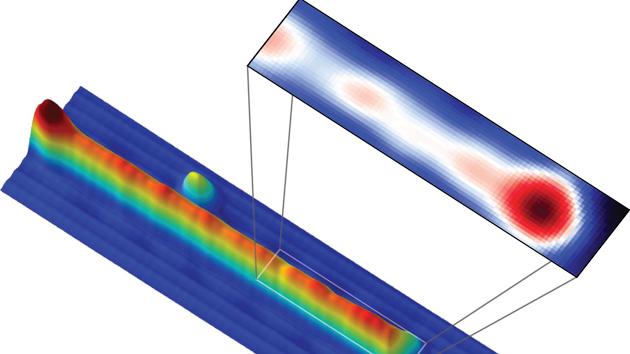Princeton
Latest

Egg whites could be key to removing microplastics from seawater
It could soon be possible to clear the oceans of microplastics thanks to a gel made from egg whites.

Study finds five major US carriers vulnerable to SIM-swapping tactics
A Princeton study (PDF) has discovered that five US prepaid carriers use authentication techniques that are vulnerable to SIM-swapping tactics. The researchers signed up for 10 prepaid accounts each on AT&T, T-Mobile, Tracfone, US Mobile and Verizon Wireless for a total of 50. They found that they only needed to successfully answer one thing to verify their identity and get the companies to switch their service to a SIM card they already have. It didn't even matter if they got the other authentication challenges wrong.

Hitting the Books: The Second Kind of Impossible
Welcome, dear readers, to Engadget's new series, Hitting the Books. With less than one in five Americans reading just for fun these days, we've done the hard work for you by scouring the internet for the most interesting, thought provoking books on science and technology we can find and delivering an easily digestible nugget of their stories.

MIT finds actual wisdom in the wisdom of crowds
To paraphrase Men In Black's Agent K, a person is smart, but people are dumb, panicky and dangerous animals. Researchers at MIT and Princeton wanted to see if, despite this, they were able to extract better information from crowds. They appear to have succeeded after developing an algorithm that looks at what people answer, but also what they believe other people will answer too.

Light-based neural network could lead to super-fast AI
It's one thing to create computers that behave like brains, but it's something else to make them perform as well as brains. Conventional circuitry can only operate so quickly as part of a neural network, even if it's sometimes much more powerful than standard computers. However, Princeton researchers might have smashed that barrier: they've built what they say is the first photonic neural network. The system mimics the brain with "neurons" that are really light waveguides cut into silicon substrates. As each of those nodes operates in a specific wavelength, you can make calculations by summing up the total power of the light as it's fed into a laser -- and the laser completes the circuit by sending light back to the nodes. The result is a machine that can calculate a differential math equation 1,960 times faster than a typical processor.

Scientists can directly observe alien planets with a new tool
Astronomers usually have to study exoplanets through roundabout ways, such as watching for the decrease in light when a planet crosses in front of a star. However, they'll soon have a reliable way to observe those alien worlds directly. A Princeton-led research team has successfully tested CHARIS, a supercooled spectrograph instrument that isolates reflected light from large planets (bigger than Jupiter) to reveal their age, mass and temperature. The key is its use of a coronagraph that separates planetary light from the host star's rays -- effectively, it's making sure the needle stands out from the haystack.

Terahertz laser tech could scan for bombs at airports
Terahertz spectrum scanning is potentially ideal for finding bombs due to the sheer range of materials it can detect, but it's not exactly practical for luggage checks when you need both a suitcase-sized machine and up to half an hour to conduct a scan. MIT researchers have a better way, though: they've developed a quantum cascade laser system that should make terahertz detection a reality. Since the laser's single, tiny frequency comb only consumes power for very brief periods, you can fit it into a part the size of a chip without a gigantic cooling unit -- perfect for airport scanners. It takes as few as 100 microseconds to identify a substance, too, so you wouldn't have to wait (longer than usual, anyway) while agents scan your bags.

ICYMI: Underwater robot snake, Earth's ocean saving and more
#fivemin-widget-blogsmith-image-54715{display:none;} .cke_show_borders #fivemin-widget-blogsmith-image-54715, #postcontentcontainer #fivemin-widget-blogsmith-image-54715{width:570px;display:block;} try{document.getElementById("fivemin-widget-blogsmith-image-54715").style.display="none";}catch(e){}Today on In Case You Missed It: Princeton researchers discovered ocean currents can move most anything around the globe within 10 years; which could help replenish dying ecosystems... and also spread around pollution. Norwegian engineers came up with a mechanical snake for underwater sea inspection and simple repair jobs near oil drills. And Harvard wants to encourage kid programming with a new robot that can be used by kindergartners to high schoolers. Once that's conquered, the answer is clearly to make the MIT open-source duckcar. As always, please share any great tech or science videos you find by using the #ICYMI hashtag on Twitter for @mskerryd.

Princeton researchers find security flaws in IoT devices
One of the main concerns about the so-called Internet of Things is security, and the recent findings of researchers at Princeton won't help ease the anxiety. Researchers at the university's Center for Information Technology Policy (CITP) took a close look at how information is transmitted between the connected devices in your home and the cloud to gauge just how secure they really are. The list of devices researched included the Belkin WeMo Switch, Nest Thermostat, Ubi Smart Speaker, Sharx Security Camera, PixStar Digital Photoframe and a SmartThings Hub. As it turns out, a few gadgets the group examined sent information out in the open.

Watch a worm's brain light up as it plots its next move
Scientists have created the first ever video of neurons firing in a freely moving animal, a technique that could lead to greater understanding about how our own brains work. The Princeton-led team first programmed a nematode worm's neurons to create a fluorescent protein that lit up in response to calcium. Since calcium is generally present when a neuron fires, that means they could literally visualize the 1 millimeter-long worm "thinking" as it wriggles around. The resulting video (below) shows 77 of the nematode's 302 neurons working in the top panel, while the bottom panel simultaneously shows its activities and brain position.

Phone data can predict infectious disease outbreaks
A team of Princeton and Harvard researchers analyzed the phone call records of 15 million users in Kenya -- not to spy on people, but to study the spread of seasonal disease. The team wanted to see if the movement of phone users can predict outbreaks of seasonal diseases like rubella or German measles. So, they used anonymous records from between June 2008 and June 2009, including locations where people made phone calls. They then compared the data to the areas where cases of rubella were reported in the country. The result? Well, it turns out the subjects' movement patterns matched the locations with the highest risk of rubella within that year-long period.

3D printing technique will put electronics into just about everything
You can use 3D printing to make a handful of electronics, such as antennas and batteries, but LEDs and semiconductors have been elusive; you usually need some other manufacturing technique to make them work, which limits what they can do and where they'll fit. A team of Princeton researchers recently solved this problem, however. They've found a way to make quantum dot LEDs (and thus semiconductors) using only a 3D printer. The scientists choose printable electrodes, polymers and semiconductors, which are dissolved in solvents to keep them from damaging underlying layers during the printing process; after that, the team uses design software to print the materials in interweaving patterns. In this case, the result is a tiny LED that you could print on to (or into) many objects, including those with curved surfaces.

Newly discovered particle is both matter and antimatter at the same time
You probably think of matter and antimatter as mortal enemies, since their equivalent particles (such as protons and antiprotons) normally destroy each other on contact. However, there are now hints that the two might get along just fine in the right circumstances. Researchers claim to have successfully imaged a Majorana particle, which exists as both matter and antimatter at the same time. The team created it by placing a string of iron atoms on top of a lead superconductor, forming pairs of electrons and antielectrons -- except for one lone electron at the end of the chain, which exhibited properties of both.

More to expect at our free Engadget Expand event in NYC!
If you're keeping score, we've announced a bunch of great speakers heading to this year's Engadget Expand (such as RJD2 and the head of DARPA, Arati Prabhakar). Of course there's plenty more where that came from and we're excited to announce what else you'll see at the Javits Center on November 7-8 in New York City!

Bring voice control to your home on the cheap with a Raspberry Pi
Siri, Cortana and Google Now are all inspired by the computers that Dave Bowman, Captain Picard and Iron Man use on a daily basis. But what if you wanted to turn your home into a voice-activated haven without those sorts of resources? Well, thanks to a Princeton students Charles Mash and Shubhro Saha, you can. The pair developed Jasper, an open-source, always-on voice control system that works on a Raspberry Pi and can easily be customized for your needs. All you need is an internet connection, one of the tiny educational boards and a USB microphone and you can ask the system to do whatever your coding ability allows. All we need now is for someone to kidnap Stephen Fry or Paul Bettany so our computer has the right level of sniffy British snark in its voice. Image credit: Cryteria/Wikimedia Commons (Hal 9000)

Facebook gets into nerd feud with Princeton, hilarity ensues
In the tech industry, barely a week goes by without one entity saying that another one is doomed. Mostly, however, we just ignore them, but when Princeton claimed that Facebook would collapse in 2017, the social network decided to get its own back. With tongue placed firmly in cheek, data scientists Mike Develin, Lada Adamic and Sean Taylor copied Princeton's slightly suspect method to discover that the university would effectively run out of students by 2021. Then the team went one step further, analyzing Google trends and Facebook likes to learn that, if social engagement stats are to be believed, the planet will run out of air at some point in 2060. If you like it when major corporations go all reductio ad absurdum on their rivals, then head down to the source link and enjoy this timely reminder that not all scientific studies are created equal.

Princeton crafts a 3D printed bionic ear with super hearing, creepy looks
Scientists have toyed with printing ear implants for ages, but they've usually been more cosmetic than functional. Princeton has just developed a bionic ear that could transcend those mere replacements to offer a full-on upgrade. Rather than seed hydrogel with cells and call it a day, the researchers 3D printed a blend of calf cells, hydrogel and an integrated, coiled antenna made from silver nanoparticles. The frankly spooky project doesn't resemble a natural ear all that closely, but it merges organic and synthetic more gracefully than inserting a chip into an existing implant. It can also expand hearing beyond normal human levels: the experimental version picks up radio waves, for example. Although the ear is just the first step on a long path toward natural-feeling bionics, it already has us wondering if we'll be actively seeking out replacement body parts in the future... not that we're about to go all Van Gogh to get them.

New Apple Store to appear near Princeton University
Matriculating students at Princeton won't have to travel very far to get their Apple fix. According to ifoAppleStore, Apple is preparing to open an Apple Store at the nearby Quaker Bridge Mall later this year. A job listing for a "Princeton" location and tips sent to ifoAppleStore suggest the new retail front will open across from the Lord & Taylor store in the mall. The store could open as early as mid-July.

Prototype magic carpet uses electrified threads to 'fly,' Aladdin pre-orders (video)
If you spent your childhood longing to fly, you're not alone -- and one Princeton grad may have come one step closer to making it a reality with a prototype magic carpet. Ok, it's not actually a rug of the magical variety, but a 4-inch piece of plastic electrified by tiny conducting threads. It works as such: by applying a current to the sheet, tiny air pockets form underneath, propelling it forward one centimeter a second. Since it requires air pockets to move forward, the carpet must stay close to the ground -- making it more like Marty McFly's hoverboard than Aladdin's preferred mode of transportation. Better yet, the inventor has plans for a solar powered version, which would free the carpet from heavy battery constraints and allow it to travel freely over larger distances. Check out the video and source after the break for more deets.

Princeton neuroscientists map your brain, play words with subjects
Don't speak. Princeton researchers know just what you're saying -- kind of. Alright, so the Ivy league team of neuroscientists, led by Prof. Matthew Botvinick, can't yet read your minds without the help of a functional MRI, but one day the group hopes to take your silent pauses and broadcast them for public consumption. By mapping highlighted areas of brain activity to words meditated upon by subjects, the group was able to create "semantic threads" based on "emotions, plans or socially oriented thoughts" associated with select neural activity. So, what good'll these high-brow word association experiments do for us? For one, it could pave the way for automatic translation machines, extending a silicon-assisted grok into our nonverbal inner worlds that churns out computer-generated chatter; giving a voice to those incapable of speech. And if it's used for bad? More terrifically horrific psychobabble poetry penned by Jewel's unencumbered mind. Actually, wait. We might be into that.










